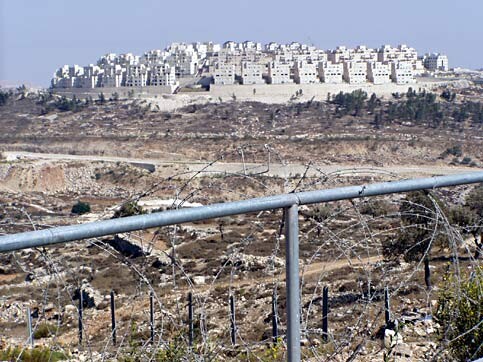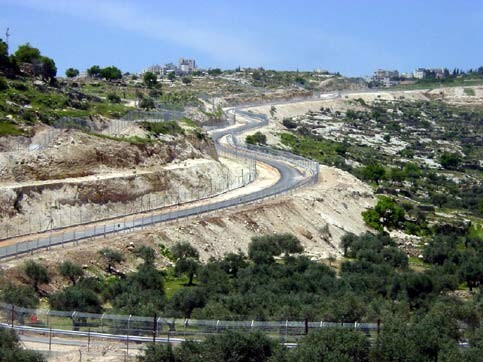
Jebel Abu Ghneim, occupied by the settlement Har Homa, northwest of Bethlehem. (PENGON)
Upon arrival in Tel Aviv, back from a holiday with Mary and the kids, a stout security guard with a friendly smile leads me deep into the Ben Gurion Airport complex for interrogation. In a small, sparsely decorated room the man shows me his Ministry of Defence insigna, and asks me how I feel.
A second person in the room, apparently a witness, brings me a plastic cup of water, staying silent, his head down. In a rather relaxed manner, the interrogator starts rolling his questions in a simple, straighforward English.
“How did you meet your wife?”
“Do you like Arab society?”
“Which Moslem teachers do you know in Bethlehem?”
The man writes wide-spaced notes, and draws arrows between my work and funders. In a light voice, he comments that he does not believe in the type of peace activities in which I am involved.
“How do you place yourself in the political field - the right, the center, the left, the far left?”
“Please listen well, this is an important question: Do you have contacts with the International Solidarity Movement or with Palestinian political factions?”
Almost apologetically, he says that it is not very common for foreigners now to live in Bethlehem.
“That’s why I ask all those questions.” And abruptly the meeting is over.
“Everything is OK, you can leave.”
A long and tiresome journey is over, too. In Budapest, from where I took an El Al plane after being stranded in Vienna because of the heavy fog, I was kept for over an hour in a lone room with three persons next door meticulously investigating my luggage.
After my hair brush was thought to contain an electronic device, a security guard panicked and started to shout at his colleagues. They disagreed about what to do with it.
Back in Bethlehem I waited ten days until Mary and the kids, and my family in law, came back from an extended holiday in Holland, Paris and Bretagne where they tasted freedom on the beach and in the forests.
“Back to the abnormal life,” Mary is used to saying upon entering Palestine. Arriving at the Allenby bridge, they had the great fortune to be able to stay in one taxi all the way up to Bethlehem. It was raining heavily. The taxi driver was nervous about soldiers checking the car, as he is not allowed to carry passengers without the relevant permits, and wanted to drop my family somewhere before ‘Azzariyyeh (Biblical Bethany).
However, Mary insisted and the man felt he could not leave the children and my old mother in law outside in the pouring rain. “How many foreign passports do you have?’” he asked, and Mary answered, in truth, “two” (for the children). Probably because of the rain the soldiers did not check all the cars, and so my family could make the journey to Bethlehem through Jerusalem rather than passing the winding and steep Wadi Nar road that goes along the east of the city and that contains a usually difficult checkpoint.
My family’s costs for the journey from Bethlehem to Amman and the return trip almost equalled a flight trip, per person about $200, including the costs of special taxis, border taxes, the entry authorization from Jordan, and a hotel in Amman. Not for poor people.
On their way to the Allenby Bridge Palestinians now sometimes stay the night in a hotel in ‘Azzariyyeh, or in Jericho. The road is full of obstacles, the latest being the Wall. The eight meter high Wall erected last week in ‘Azzariyyeh elicited the remark from locals that “even Jesus [who woke up Lazarus in Bethany/’Azzariyyeh] would not have been able to enter the city through that wall.”

“Israelis only” bypass road with multiple “buffer zones” and fencing through Bethlehem. (PENGON)
Nor are the traveling obstacles only relevant to Palestinians. Since January 4, foreign visitors (or Palestinians traveling with a foreign passport and visa) are required to have special authorization to enter Palestinian territories. According to the public announcement they even face the threat of deportation when found without permit in, for instance, Bethlehem.
But what about the tourists coming to the Church of Nativity? Do they also need to apply for a permit? I called the Dutch Representative Office in Ramallah, who commented that the Office was informed about this new ruling but that it was not yet clear how it would be implemented. It was not yet even clear where to apply for the permit.
A foreign passport holder at Bethlehem University thought the measure was an Israeli trial balloon, to test out the international reactions, and if weak, to go ahead with the implementation, at least in some areas of the West Bank. In general, the measure seems to be part of a consistent policy over the last years to keep international activists, observers, and even tourists and pilgrims away from watching and reporting about what is going on in the Palestinian areas, and to create a sense of isolation among the Palestinians.
Foreigners are supposed to share in the Israeli custom to avoid those areas, as if they are contaminated. How often have I been told by Israelis to watch out and take special care going into Bethlehem, while I myself feel always safer in Bethlehem than in Jerusalem? Lately a friend said that the “walls are closing in on you.” How true.
Back at work, teachers at a workshop jointly tell me how Bethlehem is going to hemmed in by the Wall. At the south-east, a Bethlehem University graduates’ apartment building project is threatened by the Wall near Khilit al-Jooz. The case has been brought to the Israeli High Court, like the Wall destined to come around Rachel’s Tomb.

The Wall is to be built 3 meters in front of this home in Aida refugee camp, Bethlehem. (PENGON)
Another teacher tells how on the west side of the Bethlehem area, the beautiful fields of Cremisan, the Salesian monastery, will be cut off from Beit Jala. On the north the already existing wired fence separates Bethlehem from its olive groves now annexed to Har Homa/Abu Ghneim. To the south we expect the Wall being established near the Gush Etzion settlements. The story has become familiar: Institutes will be separated from their clients, families from each other, peasants from their lands, children from schools.
Physically, with this Wall everywhere in view, the feeling of isolation will be overwhelming. Economically, this barrier to trade will seal the fate of the Palestinian communities in the West Bank. Already at present, more than 70% of the Bethlehem population is unemployed, according to the Applied Research Institute in Bethlehem, compared to 60% a year ago.
Furthermore, international aid organizations may decide to largely leave the occupied territories because they do not want to subsidize the occupier who is after all responsible for the welfare of the population under its control. So the Palestinians here have a chance to become a much talked about but humanly forgotten group. In a simple gesture to counter such a tendency, we at the Institute in Bethlehem received many hundreds of Christmas prayers and wishes collected by the peace movement Pax Christi in different countries of the world. A consolation, even though a symbolic one.
Jara, back to school, reads in her social studies textbook about fishing in Gaza. It is recommended that she and her teacher should visit Gaza and the fishermen there, as if it is at all possible for West Bank school students to visit Gaza. And never mind that the fishermen in Gaza are hardly able to leave the port as the Israeli marine suspects them to smuggle weapons.
For his part, Tamer is still full of enthusiasm for the plane journeys he made. He now all the time takes the hand of his parents and visitors so as to proudly show them the plastic tayyaara [airplane] he has on his bedroom’s wall. Fortunately, both Jara and Tamer are not yet really aware that they grow up in a prison.
Toine van Teeffelen is a Dutch national, married to a Palestinian, and is a local coordinator of the United Civilians for Peace, a Dutch initiative to send civilian monitors to the West Bank and Gaza Strip.





